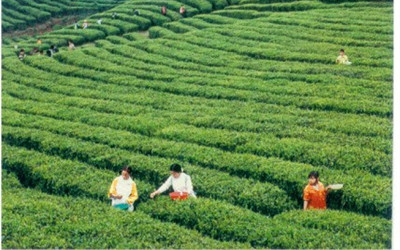Fanjing Mountain Tea is not only a specialty of Tongren City, Guizhou Province, but also a geographical indication of Chinese agricultural products.
 Fanjing Mountain Tea is originally produced in Yinjiang County, Tongren City, and is divided into two types: green tea and black tea. In the ninth year of the Yongle reign of the Ming Dynasty (1411), he was granted the title of tribute tea. High end green tea (Cuifeng) has a flat and smooth appearance, with a green and even color, a tender and long-lasting aroma, a fresh and mellow taste, and a sweet aftertaste. The soup color is tender and clear, and the leaves are tender, even, and bright. The appearance of bulk green tea is curly, bead shaped, or needle shaped, with a tender green and oily texture, a high and long-lasting aroma, and a fresh and refreshing taste. The soup color is tender green and clear, and the leaf base is tender green and bright. Fanjingshan black tea has a slender and tight appearance, with a smooth and golden appearance. It has a sweet and slightly floral aroma, with a sweet and mellow taste. The soup has a bright red color, and is tender and sprouty.
Fanjing Mountain Tea is originally produced in Yinjiang County, Tongren City, and is divided into two types: green tea and black tea. In the ninth year of the Yongle reign of the Ming Dynasty (1411), he was granted the title of tribute tea. High end green tea (Cuifeng) has a flat and smooth appearance, with a green and even color, a tender and long-lasting aroma, a fresh and mellow taste, and a sweet aftertaste. The soup color is tender and clear, and the leaves are tender, even, and bright. The appearance of bulk green tea is curly, bead shaped, or needle shaped, with a tender green and oily texture, a high and long-lasting aroma, and a fresh and refreshing taste. The soup color is tender green and clear, and the leaf base is tender green and bright. Fanjingshan black tea has a slender and tight appearance, with a smooth and golden appearance. It has a sweet and slightly floral aroma, with a sweet and mellow taste. The soup has a bright red color, and is tender and sprouty.
On November 2, 2016, the Ministry of Agriculture of China approved the registration and protection of national agricultural geographical indications for Fanjing Mountain tea.
The geographical indication protection scope of Fanjing Mountain tea agricultural products covers 122 townships in 7 counties under the jurisdiction of Tongren City, Guizhou Province, including Yinjiang County, Shiqian County, Sinan County, Dejiang County, Yanhe County, Jiangkou County, and Songtao Miao Autonomous County. The geographical coordinates are 107 ° 44 ′ -109 ° 30 ′ E longitude and 27 ° 07 ′ -29 ° 05 ′ N latitude, with a protection area of 117000 hectares.
